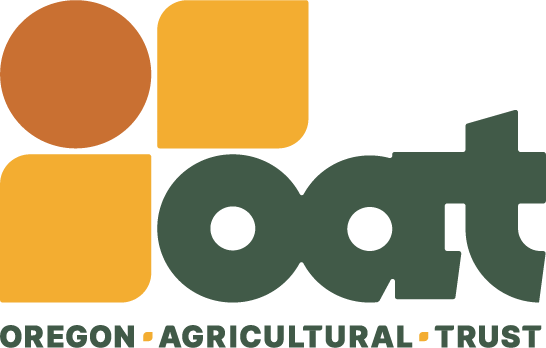Strategic Business Plan 2024-2027
The Lay of the Land
It’s been a busy three years for Oregon Agricultural Trust (OAT). We’ve grown from a staff of 1 to 8; developed relationships with hundreds of farmers and ranchers; protected 27,382 acres, with an additional 21,441 acres planned for protection by Spring, 2024, and another 96,264 acres in the pipeline; our Education program is training 500 farmers and ranchers and 250 service providers per year on easements and succession; and our revenue streams are growing in diversity and size. All this was in service of our first strategic plan.
OAT’s 2024-2027 strategic plan builds on the credibility and momentum established during our first three years with targeted and ambitious goals.
Our Land Program will prioritize protecting agricultural properties in our four focal regions across the state and expanding the areas of focus when and where there is sufficient interest, support, and capacity.
Our Agricultural Business Support Program will continue to educate producers and service providers on succession and easements, while taking the next step of providing one-on-one succession guidance.
Our Technical Assistance Program will build community capacity for protecting agricultural land.
Our Public Support & Policy Program will prioritize increasing local, state, and federal funding for agricultural producers and agricultural land protection.
We’re increasing community awareness and support of OAT’s work through creative utilization of various communication channels.
And at the foundation of all of our work is a sustainable business model, supported by revenue streams that continue to grow in diversity and size.
What We Do
From dairy farmers on the coast to wheat growers on the Eastern side of the state, Oregon’s farms and ranches support vibrant rural economies, provide habitat and open space as well as sustain our food systems. Yet in the next twenty years, 60% of Oregon’s nearly 38,000 farms and ranches are expected to change hands. Land that passes without a succession plan is more likely to be fragmented, developed, and taken out of production.
OAT’s working to change the dynamic by supporting intergenerational land transfer with working land easements as a tool to not only protect the land base, but make land more affordable to an increasingly diverse next generation of farmers and ranchers.
As OAT moves into our fourth year, staff and board worked together to refine our approach in our new strategic plan and to back it with a successful business model. We invite you to explore our plan, ask us questions, and join us in achieving our vision as a member, a volunteer, a land protection partner, a participant in our succession planning program, and as an ambassador for this work.
Mission
We partner with farmers and ranchers to protect agricultural lands for the benefit of Oregon’s economy, communities, and landscapes.
Theory of Success
OAT mitigates the loss of Oregon’s agricultural land due to fragmentation, development, and poor succession planning by mobilizing private and government funding to connect agricultural producers to land protection tools, financial resources, and training to protect agricultural land and keep farms and ranches in business across multiple generations.
Vision
We envision a future in which Oregon’s agricultural lands are protected and productive, and where farmers and ranchers are thriving.
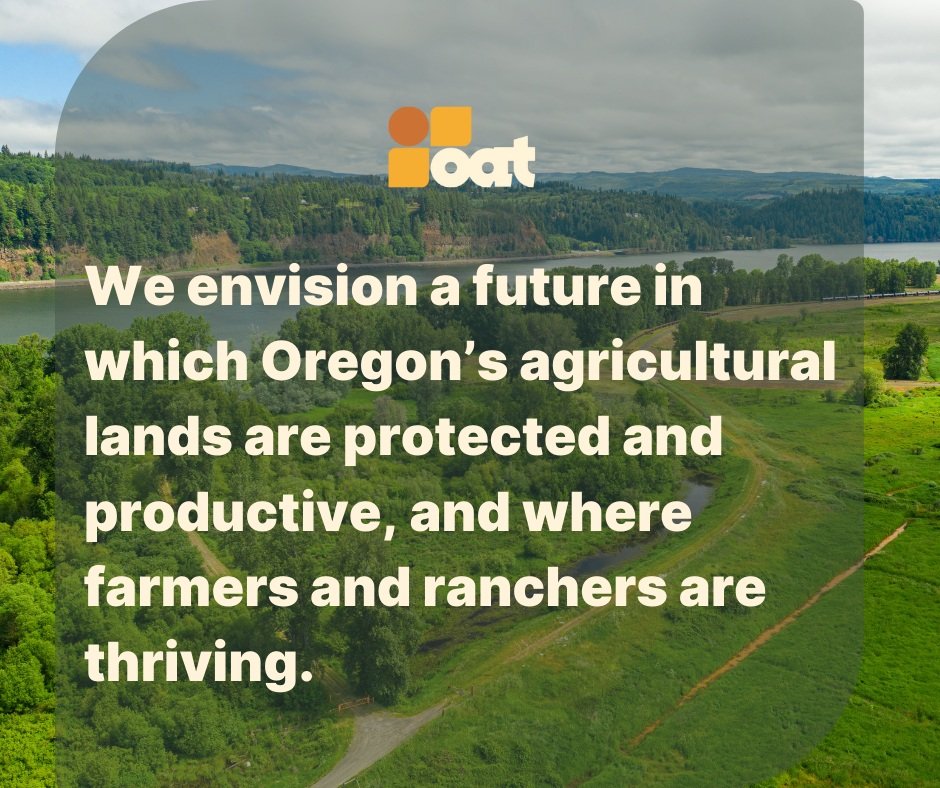
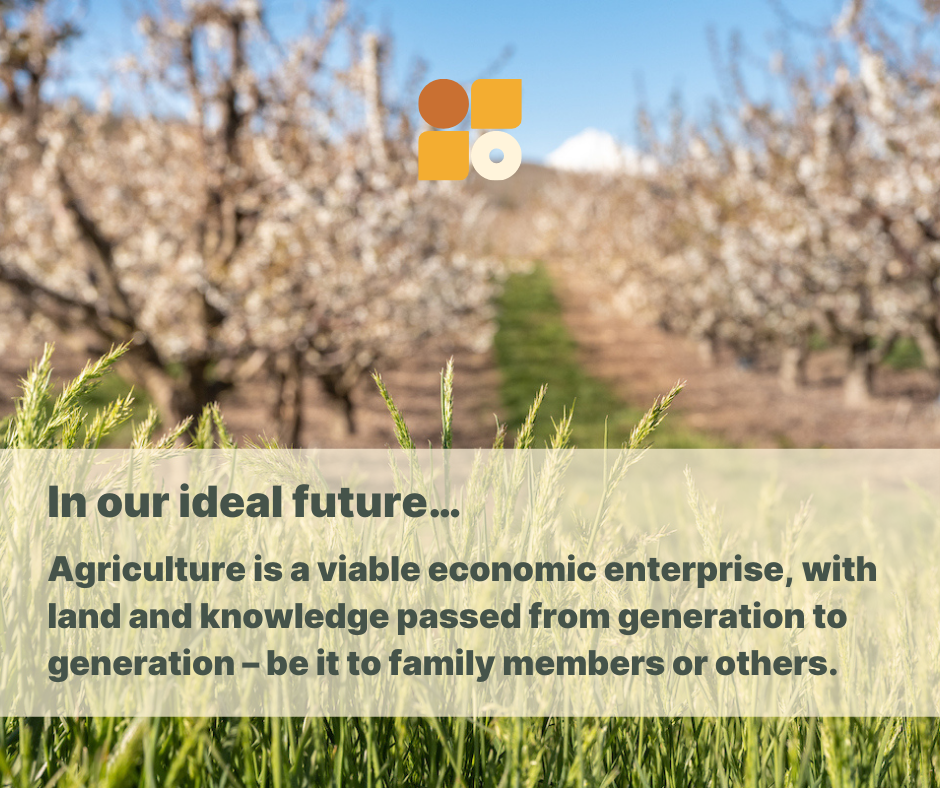
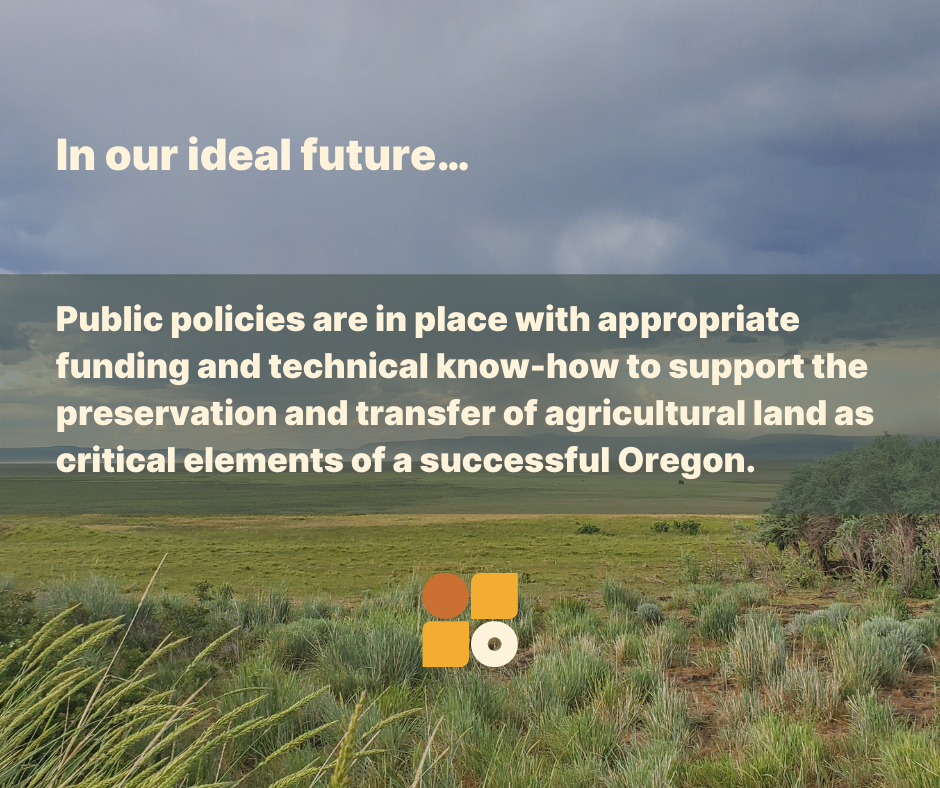


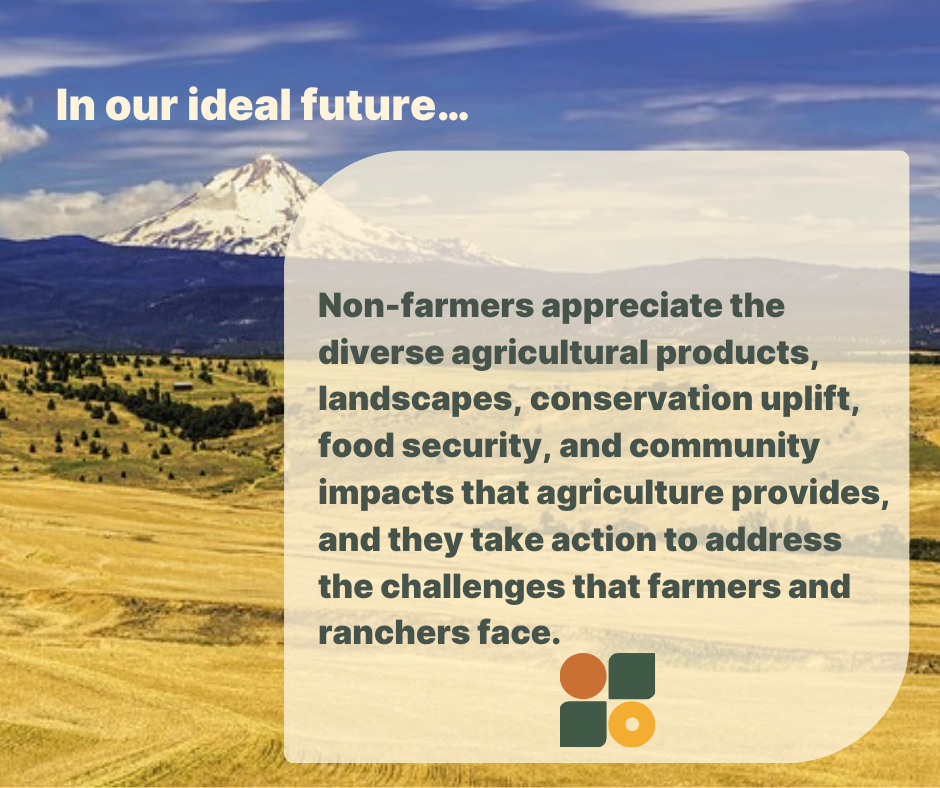
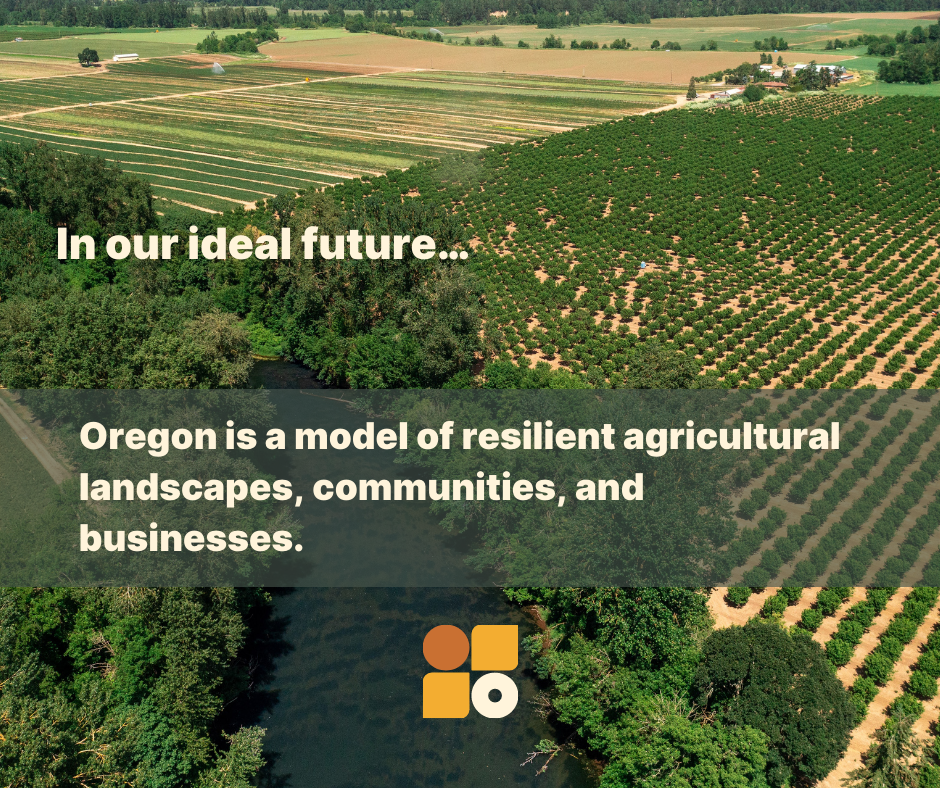
“An important issue for us is not just protecting the land and keeping it in farm and forest, but making it financially accessible to the next generation. We bought it at a time when you could afford it. Land these days is tremendously expensive and most young farmers can't afford land. Having an easement restricts development options, makes land less a commodity and hopefully can keep it more affordable.”- Jan Wallinder, Forest Edge Vineyard
Program Goals
Land Protection
-
Goal 1: Agricultural properties that are meaningful to producers and diverse in geography, business model, and owner demographics are protected and stewarded.
Strategy 1: Protect two or more agriculturally significant properties, as defined in our Farm and Ranch Protection Plan, in each of our 4 focus regions.
Strategy 2, DEIJ: Protect two or more properties that facilitate land access to diverse and/or first-generation farmers and ranchers, with the support of our Ag Business Support Program.
Strategy 3: Provide for the perpetual stewardship of OAT’s protected properties through annual monitoring, enforcement as needed, and wise management of lands owned in fee title.
Strategy 4: Update OAT’s Farm and Ranch Protection Plan in 2026.
Strategy 5: Expand services to new geographies where there is alignment with our mission, collaboration and support from partner organizations, demand from farmers and ranchers, and capacity for OAT.
Goal 2: Regional partnerships result in the protection of agricultural land, along with related goals.
Strategy 1: Develop meaningful regional partnerships where there is interest, will, and match funding to support joint grant applications.
Strategy 2: Be a voice at the table of relevant agricultural and natural resource conversations.
Agricultural Business Support
-
Goal 1: Partner with other organizations to educate and prepare farmers and ranchers to take the next steps on easements, succession, and business matters.
Strategy 1: Organize or present at impactful events that provide information, inspiration, and next steps for farm and ranch longevity, including succession, easements, and financial health.
Objective 1, DEIJ: Educational formats include accessibility features, like food, translation, daycare, and captioning, where appropriate.
Objective 2, DEIJ: Participate in at least 2 events per year specifically about non-familial succession and how to incorporate an easement as a tool for land access, with a focus on diverse participants.
Strategy 2, DEIJ: Support organizational partners in connecting different generations of producers for non-familial succession.
Strategy 3: Farmers and ranchers receive one-on-one services to help keep agricultural business in production into the future, with easements as a tool.
Goal 2: A knowledgeable network of service providers is available to support producers on easements, succession planning and business matters.
Strategy 1: Develop service providers’ ability and capacity to provide relevant educational experiences and/or resources.
Strategy 2, DEIJ: Engage presenters who represent diverse backgrounds, perspectives, and experiences.
Strategy 3: Build and responsibly share a referral list of service providers.
Technical Assistance
-
Goal 1: OAT responsibly accepts fee-for-service contracts that further our mission and increase our revenue, and for which we are suited and have capacity.
Goal 2: Land protection organizations and government agencies have increased capacity for agricultural land protection. Our menu of services includes:
Helping peer organizations create plans to conserve agricultural land.
Doing land or easement transactions for peer organizations.
Monitoring peer organizations’ protected agricultural lands.
Facilitate or manage collaboratives on behalf of outside groups.
Partnering with underrepresented communities to achieve their goals related to agricultural land (DEIJ)
Public Support & Policy
-
Goal 1: Oregon has enough funding to satisfy the demand for agricultural land protection from federal, state, and local sources
Goal 2: State laws and policies benefit agricultural land protection and agricultural businesses.
Communications
-
Goal 1: OAT staff, board, and community build OAT’s brand through clear and passionate word-of-mouth communications.
Goal 2: OAT’s website is inclusive and accessible, provides relevant information to our audiences, and encourages donations and action.
Goal 3: OAT’s email marketing and social media platforms engage new audiences and “move them up the ladder” of engagement with OAT.
Goal 4: OAT has a positive and increasingly trusted reputation in earned media.
Goal 5: OAT’s mailings and other print materials result in long-term identification with the organization and increasing donations.
Goal 6, DEIJ: OAT continually improves the accessibility and relevance of our materials for diverse audiences.
“I joined the OAT board because I was impressed with their vision to protect Oregon agriculture now and well into the future. Not only are OAT's land programs protecting the agricultural land base in the state, but their educational programs are focused on supporting the producers that work those lands today. This interconnectedness is key to insuring stability for generations to come." - Tess Baker, OAT Board Member
Systems
-
Goal 1: OAT receives external certifications of our organizational health and sustainability.
Strategy 1: OAT is accredited by 2025.
Strategy 2: OAT is certified by NRCS for ACEP-ALE and RCPP by 2027.
Goal 2: OAT has the necessary technology, contracted services, policies and other infrastructure to deliver our programs.
People
-
Goal 1: OAT has an inclusive candidate search and job description protocol, hiring process, onboarding process, and employee retention program.
Goal 2: OAT has staff capacity to effectively deliver on our mission.
Strategy 1: Hire 1 FTE staff to provide one-on-one succession counseling
Strategy 2: Ensure there is 1 FTE Land Program Director, at least 3 FTE regional land program specialists, and at least 1 FTE as a program Associate in 4 years. Hire stewardship staff when we can support 1 FTE on stewardship income alone (30-40 easements).
Strategy 3: Hire 1 FTE development staff.
Goal 3: OAT provides meaningful opportunities for interns and volunteers to support our mission.
Strategy 1, DEIJ: Train 3 land protection professionals or farm service providers through an internship program with a focus on recruiting interns with diverse backgrounds.
Strategy 2: Engage 10 volunteer community members per year with diverse skills and interests.
Goal 4: OAT’s Board and Committees are effective, diverse, and well-managed and individual service on them is desirable and fulfilling.
Strategy 1, DEIJ: Recruit and support a diverse and engaged board of directors with credibility, connections, and commitment to provide good governance and build key relationships.
Strategy 2: Develop a high-functioning committee structure to support and clarify the board-staff partnership.
Strategy 3, DEIJ: Provide the Board with training at least 2 times per year on topics from DEIJ to fiscal responsibility.
Strategy 4: Institute an annual board satisfaction and service survey.
Fund Development
-
Goal 1: Diversification of revenue.
Strategy 1: No individual funding source accounts for more than 33% of annual budgeted revenue.
Strategy 2: No revenue category accounts for more than 50% of annual budgeted revenue.
Goal 2: Government grant support for operating costs and restricted funds increases by 30% over 4 years from $620,000 to $800,000 annually.
Goal 3: Private foundation support for operating and restricted funds increases about 10% over 4 years from $781,630 to $850,000 annually.
Goal 4: Individual giving, not including contributions to the board-designated Stewardship Fund, triples over 4 years from $45,000 to $150,000 annually.
Strategy 1: Increase the number of members from 118 to 300 over 4 years.
Strategy 2: Increase the number of monthly donors and Barnraisers (donors of $1,000 per year or more).
Strategy 4: Achieve an annual donor retention rate of 60%.
Strategy 5: Increase the percentage of donors who are farmers and ranchers to 40%.
Strategy 6: Cultivate and receive mutually beneficial property donations, major gifts, and legacy gifts.
Goal 5: Corporate sponsorships triple over 4 years from $35,000 to $100,000 annually.
Goal 6: Fee-for-service funding increases sixfold over 4 years from $25,000 to $150,000 annually.
Goal 7: OAT’s board designated funds have sufficient capital, are well invested, and have appropriate liquidity.
Strategy 1: OAT’s Stewardship Fund contains at least $1 million, or more as needed to provide sufficient funding to meet the stewardship obligations of our protected properties through sound investment of principal and additional contributions from landowners and other funders.
Strategy 2: OAT’s Acquisition Revolving Fund never has less than $100,000.
Strategy 3: OAT has a budget contingency surplus of 5-10% annually.
Strategy 4: OAT has 6 months operating expenses in reserves at all times.
Goal 8: OAT is positioned for a capital campaign.
